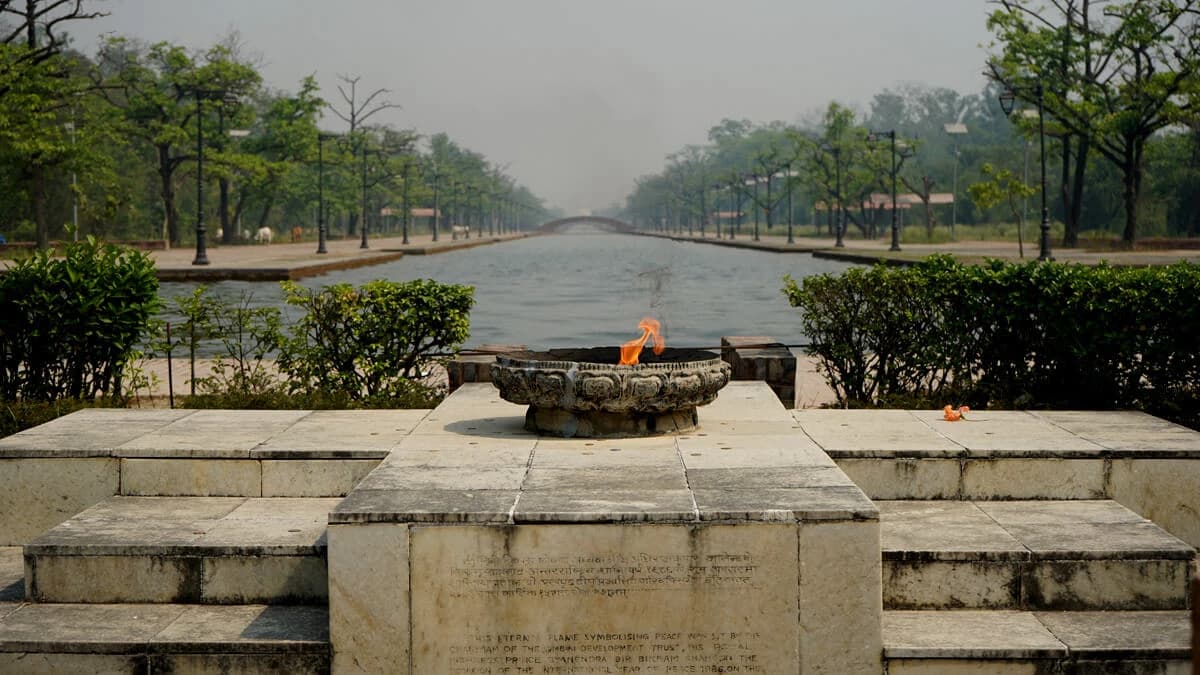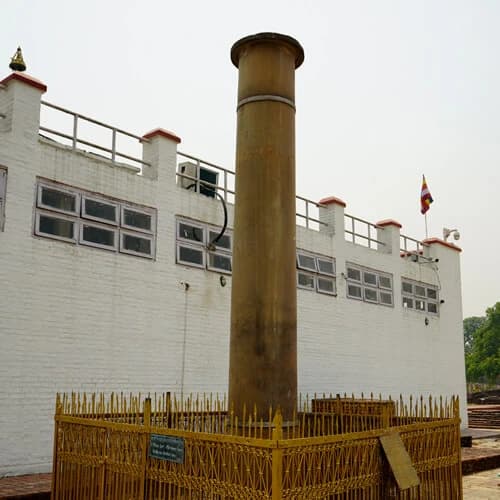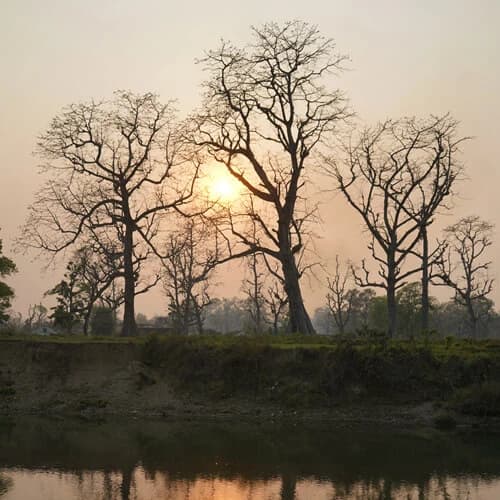The story of Lord Buddha begins in Lumbini, Nepal, more than 2600 years ago. On a moon night, Queen Mayadevi is said to have stopped here to give birth to her son, Prince Siddhartha. According to historical accounts, the prince would find enlightenment and become Gautam Buddha 35 years later. Lumbini is one of four holy pilgrimages for millions of Buddhists worldwide and has been announced as a World Heritage Site since 1997. In 249 BC, Indian Emperor Ashoka visited Lumbini and left a stone pillar as a tribute to Buddha. Thousands of travelers and devotees visit the site every year to learn, experience, and immerse themselves in the teaching and guidance of Gautam Buddha.
Where Was Lord Buddha Born ?
Lumbini, the Birthplace of the Lord Buddha
Lord Buddha was born to King Suddhodhana and Queen Maya Devi, the rulers of the Shakya clan, hence the title Shakyamuni, which means “sage of the Shakya clan." Stories have been passed down for generations that his conception and birth were miraculous. His mother, Maya, dreamed of a white elephant entering her womb. The Lord Buddha was born in 623 B.C. in Lumbini, situated in the Terai plains of southern Nepal. Legend has it that Queen Mayadevi bathed in a pond and gave birth to Lord Buddha under a sal tree in a garden of Lumbini. After his birth, Prince Siddhartha walked seven steps to the north and announced no more rebirth for him, indicating his destiny. He was then given a purification bath in the pond where Queen Maya had bathed. Thus, Lumbini has become a spiritual palace and a destination for devotees to experience peace and tranquility. You can explore the holy site and visit the pond where Queen Maya and Prince Siddhartha had taken the purification bath. Player flags hang from the tree branches and sway gently as worshippers meditate in the garden. Join thousands of pilgrims who have journeyed hundreds of miles and engage in the life-changing spiritual experience.
Path to Enlightenment
Once Siddhartha was brought back to the castle after his birth, he was presented to an astrologer. He predicted that the prince would become a great religious teacher or a king and was given the name Siddhartha, which meant “He who achieves His Goal.” In response to the astrologer, King Suddhodhana decided to keep Siddhartha away from any unpleasantness as it might prompt him to seek a life of renunciation as a religious teacher. Thus, the prince grew up surrounded by comfort in the palace, unaware of disease, poverty, and old age. However, despite the King’s efforts, Prince Siddhartha made three chariot rides outside of the palace at age twenty-nine and saw a corpse, a sick person, and an old person. On his fourth trip, he saw a wandering man, which inspired him to follow the path of freedom from the suffering caused by an infinite cycle of birth, death, and rebirth. Siddhartha became Lord Buddha after defeating the demon Mara and reaching enlightenment at the age of thirty-five.
Lumbini’s Historical Significance
A significant landmark within the Mayadevi Temple complex is the Ashoka Pillar. In 249 B.C., Indian emperor Ashoka built it to memorialize Lord Buddha. This pillar remains a vital piece of historical evidence confirming Lumbini as Buddha's birthplace. It is also evidence of Ashoka's devotion to Buddhism and his efforts to spread its teachings. The archaeological remnants, including stupas from the 3rd century B.C., emphasize the site's long-standing religious importance. Apart from the central pilgrimage site, the region around Lumbini is rich with historical landmarks connected to Buddha's life. Some famous sites include:
- Kapilavastu is about 30 kilometers from Lumbini. Lord Buddha spent his early years in this ancient city. Archaeological excavations have revealed remnants of palaces and other structures, which offer a glimpse into Buddha's royal life before his spiritual awakening.
- Kudan: This site is significant for its association with key events in Buddha's life, including his reunion with his father and the ordination of his son. The ruins of stupas and viharas at Kudan highlight its historical importance.
- Devadaha: Devadaha is located about 57 kilometers from Lumbini. It was the maternal home of Buddha's mother, Queen Mayadevi. Numerous monuments and archaeological finds honor Queen Mayadevi and her role in Buddha's life.
A Spiritual Pilgrimage
Visiting Lumbini is a physical journey and a profound spiritual experience for devotees. It is one of the holy sites that Buddha advised his followers to visit alongside Bodh Gaya, Sarnath, and Kushinagar. Pilgrims from all over the world come to Lumbini to meditate, reflect, and connect with the teachings of Buddha.
How to Get There
Lumbini is well-connected to the rest of Nepal. The Siddhartha Highway links it to major cities. The nearest airport is in Bhairahwa. Private airlines and national carriers operate daily flights to Bhairahwa from Kathmandu and Pokhara. Additionally, the Indo-Nepal border town of Sunauli is just 22 kilometers away.
The newly opened Gautam Buddha International Airport in Bhairahwa further facilitates access to flights from various international hubs. Currently, Al Jazeera Airlines operates flights from Kuwait, and Himalaya Airlines connects Bhairahwa to Kuala Lumpur. Moreover, future plans aim to expand these connections, making it easier for international pilgrims to visit Lumbini directly.
Lumbini Master Plan
- The Lumbini Master Plan was initiated to enhance the pilgrimage experience in 1978. It was designed by Japanese architect Kenzo Tange. The plan divides Lumbini into three main zones: the Sacred Garden, the Monastic Zone, and the New Lumbini Village. Each zone serves a unique purpose, blending spiritual, cultural, and practical elements.
- Sacred Garden: This zone is the heart of Lumbini, where the Mayadevi Temple and other significant archaeological remains are located. It represents enlightenment and is designed to offer a peaceful environment for meditation and reflection.
- Monastic Zone: This area features monasteries built by various Buddhist countries. Each monastery showcases distinct architectural styles and cultural traditions, reflecting the diversity within Buddhism.
- New Lumbini Village: This zone is located at the northern end of the site and includes the Peace Pagoda, the Lumbini Museum, and commercial areas. It symbolizes the worldly aspect of life and provides services for visitors.
Monasteries and Meditation Centers
Lumbini is home to over 30 monasteries, each constructed by different Buddhist communities worldwide. These monasteries are open to the public and offer unique insights into Buddhist architecture and cultural diversity. Visitors can also participate in meditation sessions and interact with monks spreading the teachings of Buddha.
Other Attractions
- World Peace Pagoda: The Japanese Buddha Sangha built this striking white pagoda, which is located to the north of the Sacred Garden. It features statues of Lord Buddha facing in four directions and symbolizes peace and harmony.
- Tilaurakot is about 25 kilometers from Lumbini. This village contains the ruins of the ancient Sakya kingdom, where Buddha spent his first 29 years. The archaeological site includes remnants of palaces, temples, and other structures.
- Crane Sanctuary: This sanctuary is close to the World Peace Pagoda and provides a habitat for Sarus cranes. It is a peaceful spot where visitors can enjoy nature and bird watching.
- Kudan: It is located about six kilometers from Tilaurakot. This archaeological site includes ruins of viharas, stupas, and other structures. It is historically significant as the place where Buddha met his father after leaving the palace and where his son was ordained (make someone a priest).
Best Season to Visit Lumbini
The best time to visit Lumbini is during autumn and winter when the weather is cool and pleasant. Spring and summer can be hot and humid, with temperatures exceeding 40°C. If you visit during summer, remember to carry sunscreen and insect repellent. Besides, Buddha Jayanti is an exceptional time to visit Lumbini as well. It is the birth anniversary of Lord Buddha when devotees come to celebrate, pray, and meditate in the holy site. You must remember that the date of Buddha's birthday is based on the Asian Lunar calendar. The event usually falls on the month of Baisakh/April. However, it falls in June during the leap year.
Lumbini is a site of unparalleled spiritual and historical significance. It offers a unique opportunity to walk in Buddha's footsteps, explore ancient ruins, and experience peace and spirituality. Whether you are a devout Buddhist or a curious traveler, visiting Lumbini is a journey into the heart of one of the world's great religions.
Plan your visit to include these historical and spiritual landmarks and immerse yourself in this sacred place's beauty and significance. For a comprehensive and enriching experience, we recommend our 5-day tours to Nepal, including Lumbini.
Some Most Popular Treks
- Everest Base Camp Trek - 14 Days
- 12 Days Everest Base Camp Trek
- Everest Base Camp Luxury - 14 Days
- Everest Cho La Pass - 17 Days
- Everest High Pass 16 - Days
- Annapurna Base Camp - 13 Days
- Ghorepani Poon Hill - 7 Days
- Annapurna Circuit - 17 Days
- 12 Days Annapurna Circuit Trek
- Manaslu Circuit - 14 Days
- Manaslu Trek 12 Days
- Everest Base Camp with Island Peak - 16 Days
- Everest Luxury Trek with Helicopter Return
- Langtang Valley - 10 Days




